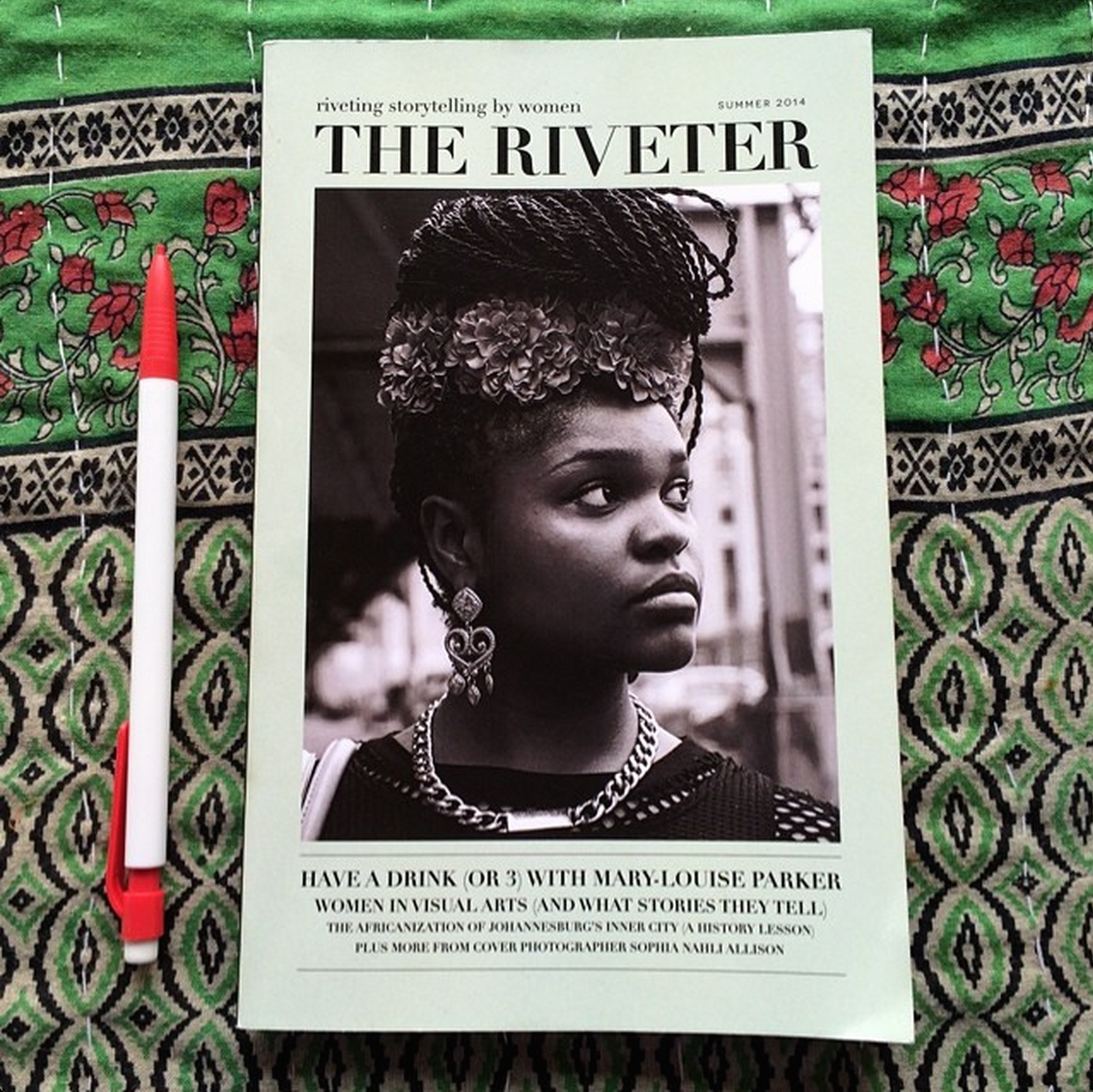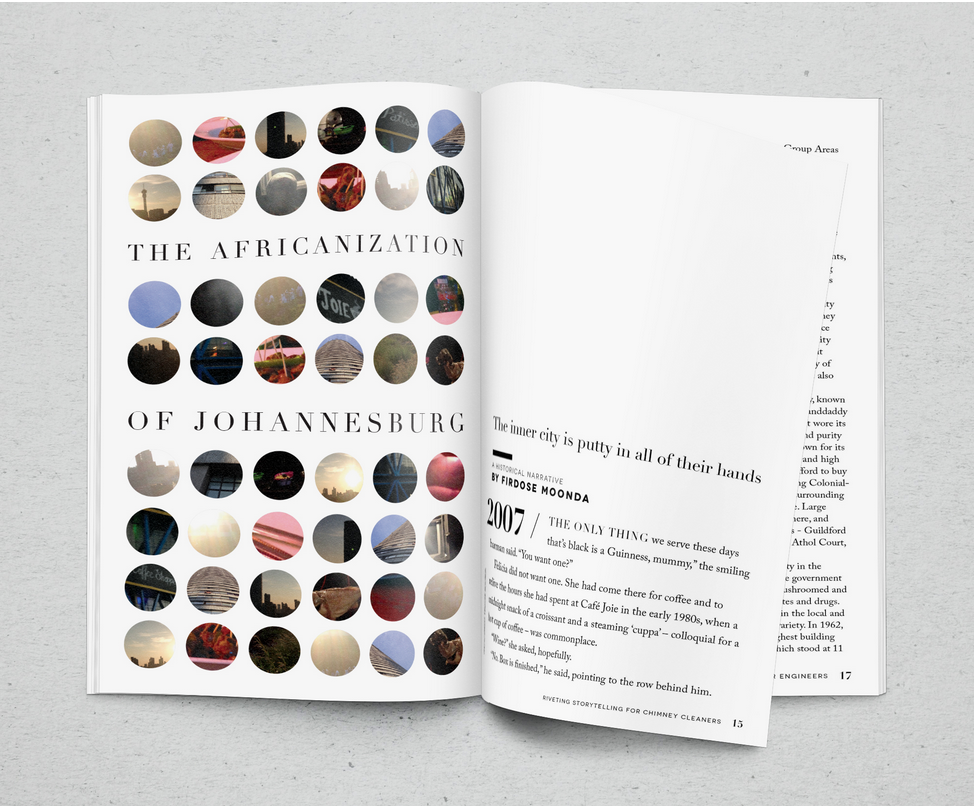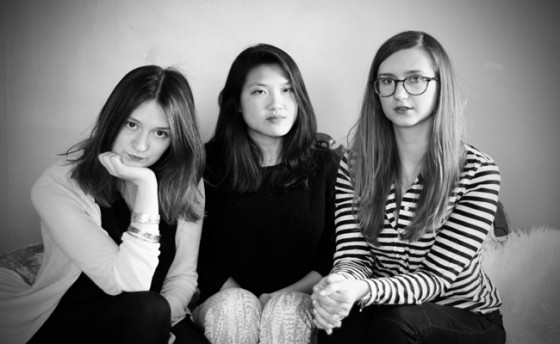
The Riveter's second issue was published in summer 2014, and its third issue is set to publish this fall.
Sager’s response, in essence: You tell me.
Two years on from that exchange, Kaylen Ralph and Joanna Demkiewicz find themselves running a small but gutsy magazine by, about and for women: The Riveter. Their venture is fueled by crowdfunding and income from day jobs, and stoked by the question: Is there a future for women in longform journalism? It also is an act of defiance at a time when larger industry trends that say longform journalism is a luxury of the past, print is dying, and women’s magazines are defined more by fluff and fashion than serious storytelling.
When The Riveter launched in 2013, its motto was “longform journalism by women for everyone,” says Demkiewicz, one of the magazine’s founders. It has since shed that ambiguous stance to embrace a target audience of women, ages 23-40, and a mantra of “unapologetically feminine.” “In the beginning, we didn’t call ourselves a women’s magazine because we were afraid, honestly,” Demkiewicz says. “I’ll openly read Esquire, but a man doesn’t usually pull out Marie Claire on the subway. Now, we want to be very unapologetic about what it means to be a woman, and our content reflects that.”
The Riveter has beaten the early odds against start-ups, and its founders are now focusing on a way to sustain those efforts. This past March they raised $35,815 in a Kickstarter campaign designed to build a subscription base. With that funding, the magazine will print about 1,000 copies of its third issue this September and will publish quarterly next year, giving The Riveter team time to build a strategy to survive beyond that.

In the second print issue of The Riveter, ESPN cricket correspondent Firdose Moonda offers a historical narrative about the Africanization of Johannesburg’s inner city.
But before The Riveter was making waves, Ralph and Demkiewicz were students at the University of Missouri School of Journalism attending a highly publicized panel, sponsored by one of their magazine professors, that featured writers whose work was included in a new anthology, “Next Wave: America’s New Generation of Great Literary Journalists.” The anthology was the collaboration of award-winning longform journalists Walt Harrington and Mike Sager. Harrington had worked for The Washington Post Magazine, authored several books and now taught at the University of Illinois at Urbana-Champaign. Sager had worked at The Washington Post with Harrington years earlier before becoming a writer-at-large for Esquire magazine. He had authored several books and then founded his own publishing house, The Sager Group.
As Ralph and Demkiewicz listened to their tales of stories and career, they realized two things: All of the writers on the panel were men. Only three of the 19 writers featured in “Next Wave” were women.
That’s when Ralph and Demkiewicz experienced their own next wave of frustration. Apparently they weren’t alone. Demkiewicz says another female student in the crowd challenged Sager to explain why there were only three women in the anthology. As she remembers it, the room “got tense.” “It was like everyone in that room was thinking, ‘We’re just students; can we challenge something like this?’” Demkiewicz says.
Ralph and Demkiewicz texted each other from across the room with the same sentence: “We’re doing it.” By “it,” they meant creating a magazine that would carry the kind of stories they themselves aspired to write – longform narratives from a female perspective. After the panel, they approached Sager to express their frustration, and to declare their plans to create their own magazine. Ralph and Demkiewicz then walked down the street to a coffee shop and purchased the domain for their new WordPress site.
Sager remembers the encounter well – an encounter that would lead to its own surprising collaboration. “They said they were unhappy,” he says. “So I said do something, and they said that they would. And they actually did, as remarkable as that is.”
If The Riveter continues to succeed, it will be in the face of stubborn odds. Consider the VIDA Count, a research-driven organization that strives to increase critical attention to women’s writing and to build transparency around gender equality issues in literature, according to its website. According to the 2014 report, Harper’s reported more than double the bylines for men than women; The New Yorker recorded 457 bylines for men and 193 for women. The 2013 and 2012 reports mirrored the same trend.
Demkiewicz remembers looking around in one of her classes at the University of Missouri, where she and Ralph became friends. About 70 percent of her classmates were female, yet the 2012 American Society of Magazine Editors’ National Magazine Awards had just been announced, and no women had even been nominated in several high profile categories. “Maybe it’s dramatic or clichéd, but it’s kind of like every woman’s life flashed before my eyes, and I didn’t like what it looked like,” Demkiewicz says. “Why work so hard in an academic setting only to ‘disappear’ in a professional setting? I think there was a flash of despair and then an immediate refusal to continue to allow women to get so easily buried or pigeonholed. I was like, fuck this, I am not spending money on journalism school just to be faced with such archaic social and professional obstacles.”
The result of that refusal is The Riveter, which fills the space where “female is the norm,” while also breaking the mold of a traditional women’s magazine, Demkiewicz says.
Ralph and Demkiewicz’s quest comes with considerable sacrifice, the kind that required deferring their own individual goals. “As college seniors, we wanted to be writing for great publications,” Demkiewicz says. “We set that aside because we were so worried about women having to fit in a space in the industry that was so constricting.”
Byline disparities aside, The Riveter founders are also confronting their original question: Where do all the female journalists go? According to a September 2014 cover story in Nieman Reports, women held only 37.2 percent of journalism jobs in broadcast, print and online news medias in 2013. That’s less than a .5 percent increase since 1998, when women held 36.9 percent of jobs in journalism.
The gap The Riveter founders see in the profession they’ve chosen, however, was absent from their own childhoods. Ralph and Demkiewicz say they grew up with strong female role models and never questioned their right to follow their talent or their dreams.
Demkiewicz — executive editor of The Riveter — grew up in small-town Manchester, Iowa. As a child, she obsessed over her grandmother’s ‘power suits’ and, when her grandmother joined The World Food Prize, an international organization focused on world hunger, she imagined working within the capacity to help change the world for the better. Very early on, she imagined doing so through storytelling, in which she learned the value from her mother, an English teacher, and her father, a former radio DJ in Warsaw, Poland.
Ralph —the magazine’s editor-in-chief — grew up in Rockford, Illinois. Her father, a commercial real estate developer, and her mother, a teacher and project manager, raised their three daughters to take initiative, confront challenges and be leaders. Ralph was launching media outlets as far back as fifth-grade, when she started The Blue Pencil newspaper at her elementary school. For all her own accomplishments, Ralph, the eldest, says her two younger sisters “exude an unwavering confidence that I’m constantly in awe of.”
“It just never occurred to me growing up that it was exceptional for me to be in leadership roles because I was a girl,” Ralph says. “Nowadays there are initiatives to ‘ban bossy,’ etc., in order to encourage confidence in young girls, but I feel really lucky to have grown up in a ‘girls rule’ household where my goals and passions were taken in stride and celebrated as ‘the norm.’”

The Riveter's front women (left to right) Kaylen Ralph, Natalie Chang and Joanna Demkiewicz have beaten the early odds against start-ups, and are now focusing on a way to sustain those efforts.
Fennell cites Ms. Magazine’s history of financial instability and advertiser resistance, and the failed Jane Magazine, which was designed for women 18-34 as an alternative to the typical women’s magazines and printed its last issue in August 2007. But in the unpredictable world of digital publishing, there are signs of hope. According to a December 2014 Storyboard piece first published in Nieman Reports, niche publications have been popping up over a wide array of topics and many are highlighting longform narrative as a key selling point.
The question is whether The Riveter will thrive as a niche publication for women readers or rise to the name recognition and circulation sizes of the Cosmos, Glamours and Marie Claires of the world, he says. “Every year I teach a magazine publishing class, women ask why isn’t there an Esquire-type publication for women,” Fennell says. “One doesn’t exist now, because in the large magazine circulation categories, there hasn’t been amarket. That’s why we’re seeing smaller efforts bloom in the form of niche publications.”
It’s tempting to draw a parallel to feminist magazines that have come before, such as Bitch, Bustle or Ms. Bitch magazine launched in 1996 and now operates as a nonprofit. It’s been known for its controversial cover pages and has the goal of pointing out the “insidious, everyday sexism of popular culture,” according to its website. Bustle is a venture-capital backed online magazine that launched in 2013, and broke 11 million monthly unique visitors last July. When founder Bryan Goldberg announced he was creating Bustle, he asked, “Isn’t it time for a women’s publication that puts world news and politics alongside beauty tips?” Bustle magazine interviewed The Riveter founders in 2013, when Ralph pointed out though the magazines are different; people draw similarities because they are both easily grouped together as “women’s magazines.”
The godmother of the genre is Ms. Magazine, founded in 1972 by, among others, feminist icon Gloria Steinem, as the first national magazine with the goal to make feminist voices audible. Mary Kay Blakely, one of Ms. Magazine’s original contributing writers and one of Demkiewicz’s former professors at Missouri, warns against lumping The Riveter with earlier or other feminist magazines. “It’s going to make an original mark on its generation,” she says, due to its “unique content.”
“When I first started writing for Ms. more than 30 years ago, it was thrilling to have a place where you can publish what you can’t publish anywhere else,” Blakely says of that time, when most women’s magazines were limited to advice about marriages, babies or cosmetics. “The Riveter is doing a very similar thing now, but they are defining feminism for their generation in a new way. The kind of work they’re publishing reflects that.”
Ralph says The Riveter isn’t trying to push a feminist message, but is creating a space where female writers can publish diverse, unique and substantive work. Take this first-person perspective on the Taiwanese Sunflower Movement — which narrates how Taiwanese students are challenging corrupt politics — and this shorter but unique piece about the history of eyebrows as indication of social status.
And if this 21st century version of a women’s magazine is attempting to defy the either/or corners of content, so too does it reject the either/or restrictions of form and platform.
The magazine started as a WordPress site, but has since scrambled to find funding to establish its online and print presence. A growing network of contributors keep the online version updated daily. The magazine’s first two print issues included pieces long in content and also deep in analysis and research, Ralph says. Longform journalism doesn’t have to be long, she adds, but it does have to be complex and original in its reporting. “We don’t define longform as just word count. It’s also about level of research and depth,” Ralph says. “Though we started with a WordPress site, print has been our focus from the beginning. We believe longform is best enjoyed when you can touch and feel it on paper.”
Two years, two print issues and one successful Kickstarter campaign later, The Riveter is gaining traction.
After graduating from Missouri in 2013, Ralph and Demkiewicz launched the magazine using an Indigogo crowdfunding campaign to print (and sell out of) their first two issues. Through the campaign, they reached their goal of raising $2,000 by June 1, 2013. The following September, Ralph and Demkiewicz decided to move The Riveter, and themselves, to Minneapolis. “We knew we wanted The Riveter to be based in a city, and Minneapolis is an amazing place to be a women in a creative field,” says Ralph, who cited a study that lists Minneapolis as the fourth-best U.S. city for women entrepreneurs. “Women run the show in Minneapolis,” she says. “What a perfect setting for what we’re doing.”
Natalie Cheng, who graduated from the University of Missouri in May 2014 with both business and journalism degrees, had seen the initial Indiegogo campaign and was impressed by The Riveter’s online content. But she knew the magazine would soon need to develop a strong business side, so she reached out to the founders. She joined Ralph and Demkiewicz in Minneapolis that fall.
As chief executive officer, Cheng’s goal is to establish The Riveter as a multiplatform brand and a print quarterly. “We had put out two issues, but we’d been publishing when we had the time and the money,” Cheng says. “I felt it was time to make it a regular schedule and time to for us to say that The Riveter has really arrived.”
She quickly rejected the more traditional route of seeking venture capital funding: “With a traditional investment model, we would have to give up equity, which we didn’t want to yet as a small start up.” And instead of using the recent Kickstarter campaign as a one-time fundraiser, The Riveter team decided to use it as a combination fundraiser and subscription drive. “We weren’t saying, put faith in us so we can start something,” Cheng says. “We already had a product and we needed to maintain subscriptions to become a quarterly. The fact we did it was really validating.” The Kickstarter funds will be earmarked solely for printing costs and to pay contributors. Before Kickstarter, The Riveter paid only $75 to $100 for a longform print piece. It plans to up that to $300 to $500 per piece.
The three Riveter leaders draw no salaries at this point, but support their venture with day jobs: Cheng works by remote, managing social media and marketing for CopterShop, a consumer drone company based in Seattle; Ralph is a receptionist at a boutique salon in the Twin Cities; Demkiewicz handles publicity for a Minneapolis theatre/bowling alley/restaurant/bar, the Bryant-Lake Bowl. “I wake up, work on The Riveter, go to work, come home, work on The Riveter and go to bed,” Demkiewicz says. “We’re 100 percent ok with doing this as a labor of love for now, because we want to be sure we are always paying our writers and that we are getting our print issues out there and established.”
Despite the digital revolution, Ralph says readers are still drawn to The Riveter as a print product, whether they first discovered the magazine online or not. During the Kickstarter subscription campaign, 70 backers signed up for a digital product, while 482 backers requested variations of the print product for their support.
As is true for most publications, future revenue models are uncertain. The Riveter crew is developing a more interactive online product. For the print product, Cheng says, they hope to avoid “littering the publication with ads and distracting the reader,” and instead fund the magazine through a combination of corporate partnerships and subscriptions. “For now, we sustain The Riveter through sales of single copies and subscriptions,” Cheng says. “That won’t always be the case. Moving forward, we’re putting a lot of effort into monetizing our digital presence.”
For now, The Riveter women have plenty of passion and little expectation of big profits. But 10 years from now, Ralph says, the dream is for The Riveter to be a household name. “We’ve come a long way from drinking cider together and talking about The Riveter, and so has the magazine,” Ralph says. “We don’t see ourselves as a niche publication. We want to be on the same stands as big-name women’s magazines.”Fennell, who was a newspaper and magazine writer and award-winning magazine editor before he joined the faculty at Missouri, says the work The Riveter women are doing is needed in the journalism industry. “With more women graduating college than men, isn’t it time for a magazine like this?” Fennell says.
Meanwhile, if you ask Ralph and Demkiewicz if they are still mad about the state of journalism for female writers, they say, “Hell, yes.” Then they point to The Riveter, and say with confidence that they believe in women journalists, they believe in each other, and they believe the industry is changing. And that they will be among the ones changing it.
In addition to their labor of love on the The Riveter, Demkiewicz and Ralph helped to write an anthology of female longform journalists titled, “Newswomen: Twenty-Five Years of Front Page Journalism,” which was recently published by The Sager Group, courtesy of Mike Sager, the Esquire writer who set them off so many months ago. Sager has announced plans to publish two additional anthologies of work by women journalists. “We’ve definitely struck a chord,” Ralph says. “People are really starting to be in tune now to the gender disparity in every industry. Longform journalism is no exception. We believe that we can change that. We believe in what we’re building and where we came from and where we’re going.”


